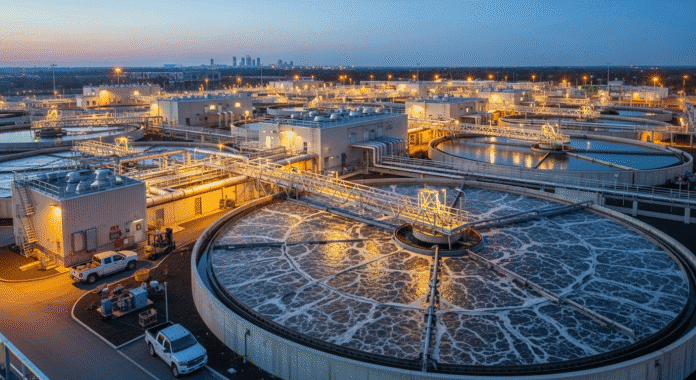Workers Barred from New Onondaga County Facility Due to Dangerous Conditions
A critical infrastructure project in Onondaga County has become a costly nightmare as toxic air conditions prevent workers from entering the new$23 million sewage treatment facility, leaving the project two years behind schedule and significantly over budget. The facility, designed to serve the county’s wastewater treatment needs, now represents a cautionary tale about construction oversight, environmental safety, and the complexities of major infrastructure development. As taxpayers bear the mounting costs and communities await essential services, this project highlights the critical importance of proper planning and execution in public infrastructure projects.
The toxic air conditions that have made the facility unsafe for human occupancy raise serious questions about construction practices, environmental controls, and quality assurance during the building process. The situation demonstrates how seemingly technical issues can escalate into major public health and financial crises that affect entire communities.
The Scope of the Crisis
Toxic Air Conditions
The presence of toxic air conditions severe enough to prevent worker entry indicates serious environmental contamination within the sewage facility. These conditions could result from various sources including improper ventilation design, chemical contamination during construction, or problems with the facility’s processing systems that create dangerous atmospheric conditions.
Identifying the specific toxic substances and their concentrations is crucial for determining both remediation strategies and potential health impacts for anyone who may have been exposed. The severity of conditions that completely prevent facility occupancy suggests contamination levels that pose immediate health threats to workers and potentially to surrounding communities.
Financial Impact
The$23 million initial investment has likely grown substantially due to the two-year delay and ongoing remediation costs. Construction delays on public infrastructure projects typically multiply costs through extended contractor agreements, additional materials, design modifications, and lost productivity. The final cost to taxpayers will likely far exceed the original budget.
Beyond direct construction costs, the delay imposes additional expenses on existing wastewater treatment systems that must continue operating beyond their intended lifespan. These facilities may require emergency repairs or upgrades to maintain service while the new plant remains unusable.
Construction and Design Issues
Planning and Oversight Questions
The toxic air crisis raises fundamental questions about the planning and oversight processes that should have prevented such problems. Major infrastructure projects require extensive environmental assessments, safety protocols, and quality control measures designed to identify and address potential hazards before they become operational crises.
The failure to anticipate or prevent toxic air conditions suggests possible gaps in the design process, construction oversight, or quality assurance procedures. Investigating these failures is essential for preventing similar problems in future projects and determining accountability for the current crisis.
Contractor and Regulatory Responsibilities
Multiple parties typically share responsibility for infrastructure project safety, including design engineers, construction contractors, and regulatory oversight agencies. Determining which parties failed to meet their responsibilities for environmental safety will be crucial for both fixing the current problem and preventing future occurrences.
Regulatory agencies responsible for approving construction plans and inspecting work may face scrutiny regarding their oversight of this project. The presence of toxic conditions that prevent facility use suggests that standard safety protocols either weren’t followed or weren’t adequate for this project’s unique challenges.
Environmental and Health Implications
Worker Safety Concerns
The immediate concern involves protecting workers who may have been exposed to toxic conditions before the full extent of the problem was recognized. These individuals may require medical monitoring and treatment, while future workers need assurance that remediation efforts have made the facility safe for occupancy.
Occupational safety regulations require employers to provide safe working conditions, meaning that the toxic air conditions represent not only construction problems but also potential violations of worker safety laws. Enforcement agencies may need to investigate compliance with safety regulations throughout the construction process.
Community Environmental Impact
While the toxic conditions currently prevent facility operation, they also raise questions about potential environmental impacts on surrounding communities. Sewage treatment facilities by nature handle hazardous materials, but they should be designed to contain these materials safely without creating external environmental threats.
The nature of the toxic contamination will determine whether surrounding air, water, or soil might be affected. Environmental testing around the facility may be necessary to ensure that the problems remain contained within the plant structures.
Infrastructure Service Disruption
Wastewater Treatment Capacity
The delayed opening of the new facility means that existing wastewater treatment infrastructure must continue serving the community beyond its intended capacity or lifespan. This situation can create risks for service reliability and environmental compliance that affect the entire county.
Older sewage treatment facilities may lack the capacity or technology needed to meet current environmental standards or population demands. Extended operation of these systems while the new facility remains unusable could create additional environmental and regulatory compliance challenges.
Long-term Service Planning
The two-year delay and ongoing problems with the new facility complicate long-term infrastructure planning for Onondaga County. Officials must balance immediate service needs with the uncertainty surrounding when the new facility will become operational.
Alternative solutions for wastewater treatment capacity may be necessary if remediation efforts prove unsuccessful or excessively time-consuming. These alternatives could include temporary facility upgrades, shared service agreements with neighboring communities, or complete project redesign.
Financial Accountability and Oversight
Cost Control and Budget Management
The project’s significant budget overruns and schedule delays highlight challenges in managing large public infrastructure projects. Effective project management requires realistic initial budgets, contingency planning for potential problems, and oversight mechanisms that identify issues before they become crises.
Taxpayers deserve accountability for the additional costs associated with this project’s problems. This accountability should include transparent reporting of all costs, clear explanations of what went wrong, and measures to prevent similar problems in future projects.
Insurance and Legal Recourse
Major construction projects typically include insurance coverage and contractual provisions that assign responsibility for problems like toxic contamination. Pursuing these remedies may help recover some of the additional costs imposed by the facility’s problems.
Legal action against responsible parties may be necessary to recover taxpayer funds spent on this problematic project. However, such actions can be complex and time-consuming, potentially delaying facility completion even further while increasing overall costs.
Remediation Challenges
Technical Solutions
Addressing toxic air conditions in a sewage treatment facility requires specialized expertise in both environmental remediation and wastewater treatment technology. The remediation approach must not only eliminate current toxic conditions but also prevent their recurrence during normal facility operations.
Potential solutions might include improved ventilation systems, chemical neutralization of toxic substances, facility redesign to eliminate contamination sources, or complete reconstruction of affected areas. Each approach carries different costs, timelines, and success probabilities.
Safety During Remediation
Workers involved in remediation efforts face the same toxic exposure risks that currently prevent normal facility operations. Protecting these workers requires specialized safety equipment, training, and protocols that add complexity and cost to remediation efforts.
The remediation process itself may create additional environmental challenges if toxic materials must be removed, transported, or disposed of safely. These activities require careful planning and oversight to prevent spreading contamination to other areas.
Lessons for Future Projects
Improved Planning and Oversight
The Onondaga County sewage facility crisis demonstrates the need for enhanced planning and oversight procedures for major infrastructure projects. This includes more thorough environmental assessments, improved quality control during construction, and better coordination between design, construction, and regulatory oversight functions.
Future projects should include more robust contingency planning for potential environmental problems and clearer accountability mechanisms when problems occur. Learning from this project’s failures can help prevent similar crises in other communities.
Public Communication
Effective communication with taxpayers and community members about infrastructure project challenges is essential for maintaining public trust and support. Transparency about problems, costs, and remediation efforts helps communities understand the complexities of major infrastructure development.
Regular updates on remediation progress and realistic timelines for facility completion help manage public expectations while demonstrating accountability for taxpayer investments in critical infrastructure.
Moving Forward
The Onondaga County sewage facility represents a significant setback for infrastructure development, but it also provides important lessons about the complexities of major construction projects and the need for comprehensive safety and quality assurance measures.
Resolving the current crisis requires sustained commitment to finding effective remediation solutions while holding responsible parties accountable for the problems that created this situation. The community deserves both a functional sewage treatment facility and assurance that similar problems will be prevented in future projects.
The ultimate success of remediation efforts will depend on technical expertise, adequate funding, and effective oversight that ensures worker safety throughout the process. While the project’s problems are serious, they are not necessarily insurmountable with proper planning and execution of remediation strategies.
For Onondaga County residents, this project serves as a reminder of both the importance of critical infrastructure and the challenges involved in delivering complex public works projects successfully. The lessons learned from this experience should inform future infrastructure investments while the community works toward finally realizing the benefits of improved wastewater treatment capacity.



